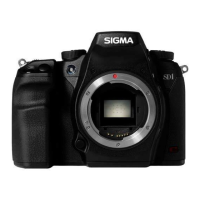Not another monochrome sensor
with color filters
The image sensor in almost all digital
cameras, with the exception of Sigma's, is
a color filter array (CFA) sensor. The image
sensor itself is monochrome; it detects light
intensity, but not color. The CFA overlaying
the sensor's light-sensitive photodiodes is a
mosaic of red, green and blue (RGB) filters
in a checkerboard-like grid. Therefore,
each photosite, corresponding to a single
pixel, receives just one of the three primary
colors.
In this kind of system, a 15MP CFA sensor
allots 7,500,000 pixels to green light and
3,750,000 each to red and blue light,
respectively. Left as is, this checkerboard
pattern would create a strange image,
so a process called color interpolation is
used to blend in neighboring pixel color
information. For example, a green pixel
gets color information from adjacent blue
and red pixels, and so on.
CFA sensor relies
on eye's sensitivity to green
Why does a CFA sensor assign twice as
many pixels to green as to red or blue?
Because the eye is most sensitive to green
light (figure 1). Human vision depends
mostly on wavelengths in the green range
to perceive fine detail and luminance
resolution.
The three charts in figure 2 all have the
same contrast. Notice how the green
background lets you detect fine detail
more easily. Most digital cameras take
advantage of this fact of human vision.
By capturing relatively more
green information, they can
get by with much less blue
and red information. Thanks
to this clever solution, a mere
monochrome image sensor
can be used to deliver color
images of high quality.
So, what's the problem?
Though it is true that our eyes
are most sensitive to green
luminance (sharpness and
contrast) information, we
also see blue and red chrominance (color)
information. But the unequal treatment
afforded these colors by a CFA sensor
causes a disparity between the luminance
resolution and chrominance resolution of
the photographic images it generates.
Unique, innovative direct image sensor
Unlike CFA sensors, the image sensor in
Sigma digital cameras uses three layers
of photodiodes to gather the entire red,
green and blue color information of light,
forming the world's one and only full
color capture system. Since introducing
its first-generation digital camera in 2002,
Sigma has maintained an unwavering
commitment to this unique technology.
The image sensor is made of silicon. When
struck by light, silicon absorbs shorter
wavelengths (blue) near its surface and
longer wavelengths (green, then red) at
deeper levels. The direct image sensor
takes advantage of this fact, using three
layers of photodiodes to capture all colors
of light at each pixel location. Like color
film in essence, this vertical structure
bypasses the need to gather different
colors at different horizontal locations.
All pixels capture full RGB color
This means that a direct image sensor
having 15,000,000 pixel locations is able
to capture full red, green and blue color
information, as is, at each pixel location. In
other words, all 15,000,000 pixel locations
can respond to all three primary RGB colors
transmitted by the lens. There is no need to
assign red, green and blue to separate pixel
locations, nor is it necessary to fabricate or
eliminate color information during image
processing. This full color capture system
is, in principle, capable of providing equally
high luminance resolution and chrominance
resolution.
Since typical photographic subjects do
contain an enormous amount of color
information, Sigma is convinced that
removing any discrepancy between
luminance resolution and chrominance
resolution is an important key to
photographic naturalism.
Unencumbered by a low-pass filter
Another thing: color filter arrays are
prone to false color patterns (moiré).
This problem is caused by interference
between repeating patterns of fine lines in
the subject and the mosaic pattern of the
color filter array itself. Moiré is typically
prevented by installing a low-pass filter in
front of the image sensor.
A low-pass filter works by removing the
higher frequencies of light that carry fine
detail. This does prevent interference
and, therefore moiré. But it also adversely
affects resolution and image sharpness.
Facing this tradeoff, some cameras use
CFA sensors without a low-pass filter,
accepting the inevitable color moiré
patterns as the price to pay for a sharper
image.
Sigma's direct image sensor design
doesn't use color filters, so it doesn't
need a low-pass filter to prevent the false
colors of moiré. The direct image sensor
captures the sharp image formed by the
lens without losing any information. As a
leading lens maker with uncompromising
standards of photographic image quality,
Sigma believes the ideal capture system
is one that receives full color information
at each and every pixel location.
Pure color and light: nothing added,
nothing lost
In CFA sensor-equipped digital cameras,
only one color is captured per pixel
location. Color interpolation is required
to generate a full color image from these
single-color pixels. Over the past decades,
color interpolation algorithms have
greatly improved, so that interpolation
errors are rarely a cause for concern in
today's digital cameras.
Nevertheless, light information lost in the
capture process can never be perfectly
reconstructed. This standard approach
cannot fulfill the promise of truly natural
images. In sharp contrast, Sigma's
direct image sensor has no use for color
interpolation and doesn't suffer from its
associated problems.
Sigma's technology generates naturally
faithful color images without needing to
add information. This is why the ambience
of the scene is so vividly captured in
photos taken with a Sigma digital camera.
This reflects Sigma's policy of protecting
the integrity of image information —
keeping the image pure.
09

